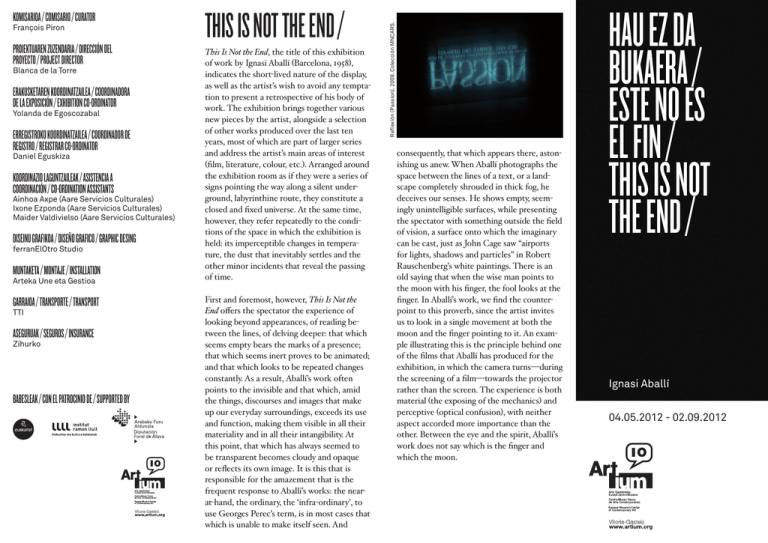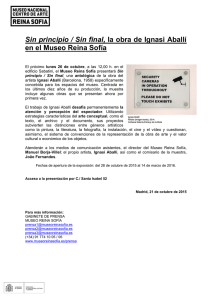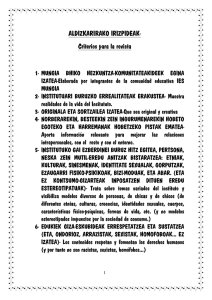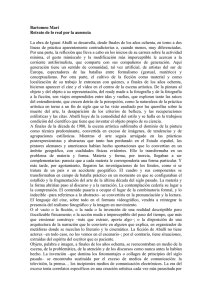HAU EZ DA BUKAERA / ESTE NO ES EL FIN / THIS IS NOT THE
Anuncio

François Piron PROIEKTUAREN ZUZENDARIA / DIRECCIÓN DEL PROYECTO / PROJECT DIRECTOR Blanca de la Torre ERAKUSKETAREN KOORDINATZAILEA / COORDINADORA DE LA EXPOSICIÓN / EXHIBITION CO-ORDINATOR Yolanda de Egoscozabal ERREGISTROKO KOORDINATZAILEA / COORDINADOR DE REGISTRO / REGISTRAR CO-ORDINATOR Daniel Eguskiza KOORDINAZIO LAGUNTZAILEAK / ASISTENCIA A COORDINACIÓN / CO-ORDINATION ASSISTANTS Ainhoa Axpe (Aare Servicios Culturales) Ixone Ezponda (Aare Servicios Culturales) Maider Valdivielso (Aare Servicios Culturales) DISEINU GRAFIKOA / DISEÑO GRAFICO / GRAPHIC DESING ferranElOtro Studio MUNTAKETA / MONTAJE / INSTALLATION Arteka Une eta Gestioa GARRAIOA / TRANSPORTE / TRANSPORT TTI ASEGURUAK / SEGUROS / INSURANCE Zihurko BABESLEAK / CON EL PATROCINIO DE / SUPPORTED BY THIS IS NOT THE END / This Is Not the End, the title of this exhibition of work by Ignasi Aballí (Barcelona, 1958), indicates the short-lived nature of the display, as well as the artist’s wish to avoid any temptation to present a retrospective of his body of work. The exhibition brings together various new pieces by the artist, alongside a selection of other works produced over the last ten years, most of which are part of larger series and address the artist’s main areas of interest (film, literature, colour, etc.). Arranged around the exhibition room as if they were a series of signs pointing the way along a silent underground, labyrinthine route, they constitute a closed and fixed universe. At the same time, however, they refer repeatedly to the conditions of the space in which the exhibition is held: its imperceptible changes in temperature, the dust that inevitably settles and the other minor incidents that reveal the passing of time. First and foremost, however, This Is Not the End offers the spectator the experience of looking beyond appearances, of reading between the lines, of delving deeper: that which seems empty bears the marks of a presence; that which seems inert proves to be animated; and that which looks to be repeated changes constantly. As a result, Aballí’s work often points to the invisible and that which, amid the things, discourses and images that make up our everyday surroundings, exceeds its use and function, making them visible in all their materiality and in all their intangibility. At this point, that which has always seemed to be transparent becomes cloudy and opaque or reflects its own image. It is this that is responsible for the amazement that is the frequent response to Aballí’s works: the nearat-hand, the ordinary, the ‘infra-ordinary’, to use Georges Perec’s term, is in most cases that which is unable to make itself seen. And Reflexión (Passion). 2009. Colección MNCARS. KOMISARIOA / COMISARIO / CURATOR consequently, that which appears there, astonishing us anew. When Aballí photographs the space between the lines of a text, or a landscape completely shrouded in thick fog, he deceives our senses. He shows empty, seemingly unintelligible surfaces, while presenting the spectator with something outside the field of vision, a surface onto which the imaginary can be cast, just as John Cage saw “airports for lights, shadows and particles” in Robert Rauschenberg’s white paintings. There is an old saying that when the wise man points to the moon with his finger, the fool looks at the finger. In Aballí’s work, we find the counterpoint to this proverb, since the artist invites us to look in a single movement at both the moon and the finger pointing to it. An example illustrating this is the principle behind one of the films that Aballí has produced for the exhibition, in which the camera turns—during the screening of a film—towards the projector rather than the screen. The experience is both material (the exposing of the mechanics) and perceptive (optical confusion), with neither aspect accorded more importance than the other. Between the eye and the spirit, Aballí’s work does not say which is the finger and which the moon. HAU EZ DA BUKAERA / ESTE NO ES EL FIN / THIS IS NOT THE END / Ignasi Aballí 04.05.2012 - 02.09.2012 Izenburuak –This Is Not The End («hau ez da bukaera»)– Ignasi Aballíren (Bartzelona, 1958) erakusketaren izaera igarokorra adierazten du, eta atzerabegirako inbentariorik ez egiteko asmoa. Erakusketan artistak azken aldian egin dituen lanak eta azken hamar urteetan egindakoen sorta bat bildu dira, artistaren interes berezien berri ematen dutenak (zinema, literatura, kolorea, eta abar). Lurrazpian legokeen labirinto isil baten erako ibilbide batean aztarna multzo gisa banatu dira erakusketa aretoan, eta mundu itxi eta finko bat eratu arren, erakusketa egin den gunearen baldintzan dituzten behin eta berriz aipagai: tenperatura aldaketa ia hautemanezinak, ezinbestean pausatzen den hautsa eta denboraren iragana ikusarazten duten eguneroko beste zenbait gertakizun. El título This Is Not The End («este no es el fin») indica, en primer lugar, el carácter transitorio de la exposición de Igasi Aballí (Barcelona, 1958) y su deseo de escapar de toda tentación de inventario retrospectivo. La exposición asocia varias obras de nueva producción del artista con una selección de obras realizadas en los últimos diez años, la mayoría de las cuales forman parte de series más extensas y que dan cuenta de los principales temas de interés del artista (el cine, la literatura, el color, etc.). Distribuidas en la sala de exposición como un conjunto de indicios dispuestos a lo largo de un itinerario laberíntico, silencioso y subterráneo, constituyen un universo cerrado y fijo, pero remiten una y otra vez a las condiciones del espacio en el que tiene lugar la exposición: a sus imperceptibles cambios de temperatura, al polvo que se posa inevitablemente y a otros incidentes cotidianos que hacen visible el paso del tiempo. This Is Not The End erakusketak esperientzia bat proposatzen dio, batez ere, ikusleari, itxuraz harago begiratzekoa, «lerro artean» irakurtzekoa, urrutirago bilatzekoa: hutsik dagoela dirudiena presentzia baten arrastoek markatuta dago, hilik dagoela dirudiena bizirik dago, errepikatzen dela dirudiena etengabe aldatzen da. Beraz, Ignasi Aballíren lanak ikusezina dena izendatzen du sarritan eta, gure eguneroko ingurua osatzen duten gauza, solas eta irudien artean, haien erabilera eta eginkizuna gainditu eta beren material tasunean ikusarazten dizkigu eta, harago, beren ukiezintasunean. Une horretatik aurrera, beti gardena iruditu zaiguna arretu eta opaku bihurtzen da, edota bere irudia islatzen du. Hortik dator Aballíren lanek gehienetan eragiten duten txundidura: hurbilena, ohikoena, «infra arrunt»ena, Georges Perec-en esapidea gogoratuz, ez da, gehienetan, ikusten ez dakiguna baizik. Aballík testu baten lerroen arteko hutsuneari, edota laino itsu batek erabat estaltzen duen paisaiari argazkia ateratzen dionean, gure zentzumenak atzi petzen ditu. Hutsik dauden azalerak erakusten ditu, itxuraz ulertezinak, eta aldi berean ikusleari eremuz kanpoko bat proposatzen dio, irudimena proiektatzeko azalera bat, John Cagek Robert Rauschenberg-en margolan zuri kolorebakarretan «argiarentzako, itzalentzako, partikulentzako aireportuak» ikusten zituen eran. Jakintsuak hatzaz ilargia erakusten duenean ergelak hatzari begiratzen diola dioen esaera zaharrak hemen du bere kontrapuntua. Izan ere, Ignasi Aballík hala ilargiari nola hura erakusten duen hatzari begiratzeko gonbidapena luzatzen du mugimendu bakarrean. Horrela, esate baterako, erakusketarako egin duen pelikuletako baten hasieran –zinemako pelikkula bat proiektatu bitartean– proiekzio tresnaren aldera itzultzen du kamera, pantailarantz zuzendu beharrean. Esperientzia materiala da (mekanika bat agerian uztea) eta pertzepziozkoa (ikusizko lilura) da aldi berean, eta ez dago besteari nagusitzen zaionik. Begiaren eta espirituaren artean, Ignasi Aballíren lanak ez dio bien artean zein den hatza, ezta ilargia zein den ere. This Is Not The End propone, ante todo, una experiencia al espectador, la de mirar más allá de las apariencias, leer «entre líneas», buscar más lejos: lo que parece vacío está marcado por las huellas de una presencia, lo que parece inerte resulta estar animado, lo que parece repetido cambia constantemente. De manera que la obra de Ignasi Aballí designa a menudo lo invisible y lo que, entre las cosas, los discursos y las imágenes que constituyen nuestro entorno cotidiano, sobrepasa su uso y su función para hacerlo ver en su materialidad y, más allá, en su intangibilidad. Desde ese momento, lo que siempre había parecido transparente se enturbia y se vuelvo opaco, o refleja su propia imagen. De ahí procede el estupor que producen la mayoría de las veces las obras de Aballí: lo más cercano, lo más común, lo más «infra-ordinario» —retomando la expresión de Georges Perec—, no es, la mayoría de las veces, que aquello que no se sabe ver. Cuando Vitrina (Glass Architecture). 2011. Fundación RAC. ESTE NO ES EL FIN / Film Proyección. 2011 HAU EZ DA BUKAERA / Aballí fotografía el espacio entre las líneas de un texto, o un paisaje totalmente oculto por una capa de espesa niebla, engaña a nuestros sentidos. Muestra superficies vacías, aparentemente ininteligibles, proponiendo al mismo tiempo al espectador un fuera de campo, una superficie de proyección para lo imaginario, del mismo modo que John Cage veía en las pinturas monocromas blancas de Robert Rauschenberg «aeropuertos para la luz, las sombras, las partículas». El proverbio que dice que cuando el sabio señala la luna con el dedo el idiota mira al dedo, encuentra aquí su contrapunto, ya que Ignasi Aballí invita a mirar en un mismo movimiento tanto a la luna como al dedo que la señala. Así, por ejemplo, el principio de una de las películas que produce para la exposición es volver —durante la proyeccción de una película de cine— la cámara hacia el aparato de proyección en lugar de dirigirlo hacia la pantalla. La experiencia es al mismo tiempo material (la puesta en evidencia de una mecánica) y perceptiva (un deslumbramiento óptico), ninguna prevalece sobre la otra. Entre el ojo y el espíritu, la obra de Ignasi Aballí no dice cuál de los dos es el dedo, ni cuál la luna.


